
Monocacy National Battlefield is a unit of the National Park Service, the site of the Battle of Monocacy in the American Civil War fought on July 9, 1864. The battlefield straddles the Monocacy River southeast of the city of Frederick, Maryland. The battle, labeled "The Battle That Saved Washington," was one of the last the Confederates would carry out in Union territory. The two opposing leaders were General Jubal Early, fighting for the South, and General Lew Wallace, fighting for the North.
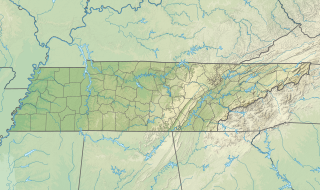
Shiloh National Military Park preserves the American Civil War Shiloh and Corinth battlefields. The main section of the park is in the unincorporated town of Shiloh, about nine miles (14 km) south of Savannah, Tennessee, with an additional area located in the city of Corinth, Mississippi, 23 miles (37 km) southwest of Shiloh. The Battle of Shiloh began a six-month struggle for the key railroad junction at Corinth. Afterward, Union forces marched from Pittsburg Landing to take Corinth in a May siege, then withstood an October Confederate counter-attack.

The Battle of Natural Bridge was fought during the American Civil War in what is now Woodville, Florida near Tallahassee on March 6, 1865. As people in Tallahassee tell the story, handed down since the civil war, a small band of Confederate troops and volunteers, mostly composed of teenagers from the nearby Florida Military and Collegiate Institute that would later become Florida State University, and the elderly, protected by breastworks, prevented a detachment of United States Colored Troops from crossing the Natural Bridge on the St. Marks River. The Natural Bridge is a 1⁄4-mile-long (400-meter) stretch along which the St. Marks River runs underground, after dropping into a sinkhole.

The Battle of Hatchie's Bridge, also known as Battle of Davis Bridge or Matamora, was fought on October 5, 1862, in Hardeman County and McNairy County, Tennessee, as the final engagement of the Iuka–Corinth Campaign of the American Civil War. Confederate Major General Earl Van Dorn's army successfully evaded capture by the Union Army, following his defeat at the Battle of Corinth.

The Battle of Munfordville was an engagement in Kentucky during the American Civil War. Victory there allowed the Confederates to temporarily strengthen their hold on the region and impair Union supply lines.

The Battle of Champion Hill of May 16, 1863, was the pivotal battle in the Vicksburg Campaign of the American Civil War (1861–1865). Union Army commander Maj. Gen. Ulysses S. Grant and the Army of the Tennessee pursued the retreating Confederate States Army under Lt. Gen. John C. Pemberton and defeated it twenty miles to the east of Vicksburg, Mississippi, leading inevitably to the Siege of Vicksburg and surrender. The battle is also known as Baker's Creek.

The Battle of Big Black River Bridge was fought on May 17, 1863, as part of the Vicksburg Campaign of the American Civil War. After a Union army commanded by Major General Ulysses S. Grant defeated Lieutenant General John C. Pemberton's Confederate army at the Battle of Champion Hill on May 16, Pemberton ordered Brigadier General John S. Bowen to hold a rear guard at the crossing of the Big Black River to buy time for the Confederate army to regroup. Union troops commanded by Major General John McClernand pursued the Confederates, and encountered Bowen's rear guard. A Union charge quickly broke the Confederate position, and during the retreat and river crossing, a rout ensued.
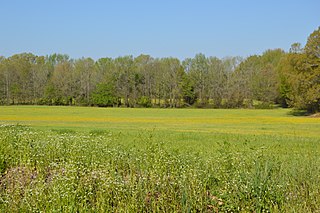
The Siege and Battle of Corinth Sites are a National Historic Landmark District encompassing surviving elements of three significant American Civil War engagements in and near Corinth, Mississippi. Included are landscape and battlefield features of the Siege of Corinth, the Second Battle of Corinth, and the lesser Battle of Hatchie's Bridge on October 5, 1862. The district includes features located in both Alcorn County, Mississippi and Hardeman County, Tennessee, with some of the former preserved as part of Shiloh National Military Park. It was designated a landmark in 1991.
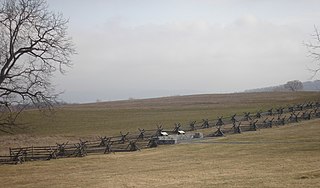
Antietam National Battlefield is a National Park Service-protected area along Antietam Creek in Sharpsburg, Washington County, northwestern Maryland. It commemorates the American Civil War Battle of Antietam that occurred on September 17, 1862.
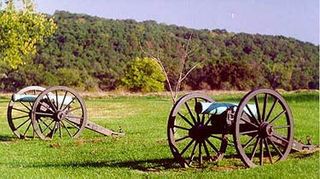
Wilson's Creek National Battlefield, located near Republic, Missouri, preserves the site of the Battle of Wilson's Creek. Fought on August 10, 1861, the battle was the first major American Civil War engagement west of the Mississippi River. In the battle, a Confederate army commanded by Benjamin McCulloch and Sterling Price defeated a smaller Union army commanded by Nathaniel Lyon. However, the Confederates were unable to hold much of Missouri, and a Confederate defeat at the Battle of Pea Ridge effectively solidified Union control of the state. Major features include a five-mile automobile tour loop, the restored 1852 Ray House, and "Bloody Hill," the site of the final stage of the battle. The site is located near Republic in southwestern Missouri just southwest of the city of Springfield. It has been a unit of the National Park Service since 1960, and was listed on the National Register of Historic Places in 1966.

Manassas National Battlefield Park is a unit of the National Park Service located in Prince William County, Virginia, north of Manassas that preserves the site of two major American Civil War battles: the First Battle of Bull Run, also called the First Battle of Manassas, and the Second Battle of Bull Run or Second Battle of Manassas. It was also where Confederate General Thomas J. Jackson acquired his nickname "Stonewall". The park was established in 1940 and listed on the National Register of Historic Places on October 15, 1966.

The Richmond National Battlefield Park commemorates 13 American Civil War sites around Richmond, Virginia, which served as the capital of the Confederate States of America for most of the war. The park connects certain features within the city with defensive fortifications and battle sites around it.
This is a list of properties and districts in Mississippi that are listed on the National Register of Historic Places. There are more than 1,400 sites distributed among all of Mississippi's 82 counties.

The Battle of Raymond was fought on May 12, 1863, near Raymond, Mississippi, during the Vicksburg Campaign of the American Civil War. After unsuccessful attempts to capture the strategic Mississippi River city of Vicksburg, Major General Ulysses S. Grant of the Union Army led another attempt, beginning in late April 1863. After crossing the river into Mississippi and winning the Battle of Port Gibson, Grant began moving east, with the intention of later turning west and attacking Vicksburg. As part of this movement, Major General James B. McPherson's 10,000 to 12,000-man XVII Corps moved towards Raymond. The Confederate commander of Vicksburg, Lieutenant General John C. Pemberton ordered Brigadier General John Gregg and his 3,000 to 4,000-strong brigade from Jackson to Raymond.

Staunton River Battlefield State Park is a state park located in Virginia. The park straddles the Staunton River in Halifax and Charlotte counties. The Roanoke visitor center in Randolph, Virginia is a railroad depot which now holds exhibits on Native Americans and railroad history. The Clover visitor center has exhibits on the American Civil War and the battle which took place on this site. It also includes information about the production of electric energy. The park also includes the Mulberry Hill plantation, given to the state in 1999.

Big Black River Railroad Bridge is a 465-foot-long (142 m) concrete open-spandrel arch bridge over the Big Black River built in 1917 near Bovina, Mississippi. It spans the river between Warren County and Hinds County; the nearest settlements are Bovina and Edwards, Mississippi.

The Magee Farm, also known as the Jacob Magee House, is a historic residence in Kushla, Alabama, United States. Built by Jacob Magee in 1848, the 1 1⁄2-story wood-frame structure is an example of the Gulf Coast Cottage style. The house is best known as the site of preliminary arrangements for the surrender of the last Confederate States Army east of the Mississippi River. Confederate General Richard Taylor negotiated a ceasefire with Union General Edward Canby at the house on April 29, 1865. Taylor's forces, comprising 47,000 Confederate troops serving in Alabama, Mississippi and Louisiana, were the last remaining Confederate force east of the Mississippi River. The Magee Farm was placed on the National Register of Historic Places on February 11, 1988. In 2004, partially through the efforts of the Civil War Trust, a division of the American Battlefield Trust, which helped save 12.6 acres of the farm, the house was opened as a museum. It ceased operation as a museum in 2010, due to a lack of public support and declining revenues, and was listed for sale. It was then listed on the Alabama Historical Commission's Places in Peril listing for 2010.

The Battle of Bayou Meto, also known as the Battle of Reed's Bridge, was fought in Pulaski County, Arkansas, during the American Civil War.
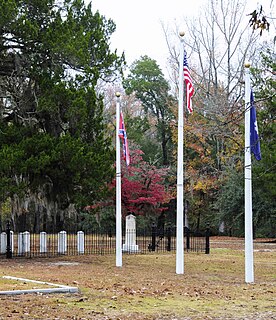
Rivers Bridge State Historic Site, also known as Rivers Bridge State Park, located near Ehrhardt, a small town in Bamberg County, South Carolina, is noteworthy as an important Civil War historic site. It is in this area that General William T. Sherman engaged the Confederate Army on his advance from Savannah, and after two days of battle, outflanked the Confederates and forced them to withdraw. River Bridge State Park was listed in the National Register of Historic Places on February 23, 1972.

The Bayou Meto Battlefield is a battlefield site of the American Civil War in Jacksonville, Arkansas. It is the location of the August 27, 1863 Battle of Bayou Meto, in which Confederate forces successfully prevented Union Army forces from crossing the Bayou Meto River during their advance to capture Little Rock. The battlefield is located on both sides of the river, on either side of Arkansas Highway 161, whose bridge is the location of the 1863 Reed's Bridge. A portion of the battlefield is now preserved as Reed's Bridge Battlefield Heritage Park. The entire battlefield is the best-preserved of the three major battle sites of the Union advance on Little Rock. A 412-acre (167 ha) area covering the core of the battlefield was listed on the National Register of Historic Places in 2002.





















